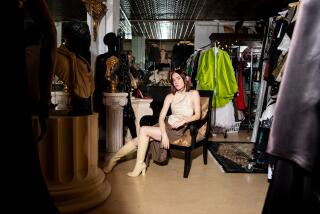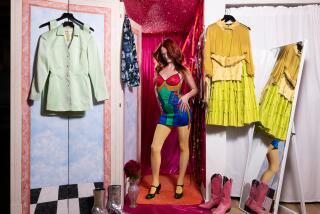Card Sharp
- Share via
These days, if you care enough to send the very best, head straight for the Claudia Laub Studio on Beverly Boulevard. For the past 20 years, the unassuming storefront has been a mecca for connoisseurs of hand-printed cards, stationery and invitations--among them, devoted clients such as Demi Moore and Bruce Willis, John Malkovich, Madonna, Julie Andrews and the Bruckheimers.
Designer Claudia Laub is as warm and inviting as her overstuffed studio. “I love the tactile,” she says. Her merry blue eyes light up as her hand brushes over sheets of beautiful, pillowy paper. Making sensual stationery is a labor-intensive process that is rarely practiced in this automated age. “You can do some wonderful, wild things on computers,” Laub admits, “but it’s not the same. I want to see the human hand in it.”
Laub starts with a selection of high-quality papers--vellums from France, Amalfi from Italy, rice paper from Japan, even a rich recycled paper. All her designs are created using handset type, handmade casts and custom-mixed soy inks. Then she prints them on two antique letter presses that reside in the back of the studio. One, a 100-year-old Chandler & Price platen press, is being used today to print small mauve poodles on note cards. The other press, a huge black Colts Armory of similar vintage that Laub affectionately calls her “locomotive,” is silent after an extremely busy holiday season. “When it’s running, it groans like a big old bear,” she says.
Laub bought her first press 20-some years ago from an elderly Frenchman returning to Paris. She took to it immediately, she says, “because I had control. When you give a design job to a printer, it doesn’t always come back looking like you envisioned it.”
The old presses allow Laub to use thick rag papers that would jam modern printers. And, as the name implies, the antique presses press the ink into the paper, creating texture. Of course, there are disadvantages to using outdated equipment: “I’m always looking for good mechanics who can fix my oscillating rollers,” Laub laughs.
Her line of cards--started as a sideline to fill the summer months when the custom stationery business falls off--is booming. Initially Laub couldn’t sell them to any Los Angeles-based stores, until Barneys New York became her first client. “When I showed up for my meeting with the buyers, they had their purses on their shoulders ready to walk out the door. Before I knew it, they were calling in other people to see the cards, their purses were on the floor and they were ready to order.” The line now includes more than 300 cards and sells in upscale stores around the world. In fact, the understated cards, often featuring dingbat-sized images surrounded by lots of negative space, are widely copied by competitors.
“I consider it a backhanded compliment to be knocked off,” Laub insists. “It lights a fire under me to come up with something new.”


